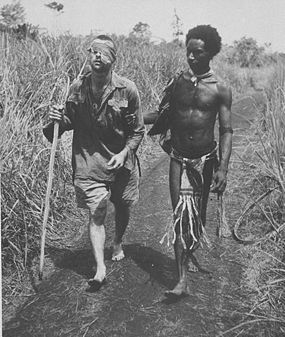
George Silk
Encyclopedia

New Zealand
New Zealand is an island country in the south-western Pacific Ocean comprising two main landmasses and numerous smaller islands. The country is situated some east of Australia across the Tasman Sea, and roughly south of the Pacific island nations of New Caledonia, Fiji, and Tonga...
, and served as a photojournalist for Life for 30 years.
Mr. Silk's career as a war photographer began in 1939, when he was a combat cameraman for the Australian government, covering action in the Middle East, North Africa and Greece
Greece
Greece , officially the Hellenic Republic , and historically Hellas or the Republic of Greece in English, is a country in southeastern Europe....
. Trapped with the famed Desert Rats at Tobruk in Libya, he was captured by German Field Marshal Erwin Rommel's
Erwin Rommel
Erwin Johannes Eugen Rommel , popularly known as the Desert Fox , was a German Field Marshal of World War II. He won the respect of both his own troops and the enemies he fought....
forces but escaped 10 days later.
He began working for Life magazine in 1943.
He photographed many events from World War II
World War II
World War II, or the Second World War , was a global conflict lasting from 1939 to 1945, involving most of the world's nations—including all of the great powers—eventually forming two opposing military alliances: the Allies and the Axis...
.
He covered the war on the Italian front, the Allied invasions of France and the Pacific.
In New Guinea
New Guinea
New Guinea is the world's second largest island, after Greenland, covering a land area of 786,000 km2. Located in the southwest Pacific Ocean, it lies geographically to the east of the Malay Archipelago, with which it is sometimes included as part of a greater Indo-Australian Archipelago...
, Mr. Silk walked 300 miles with Allied forces, an ordeal later described in the book "War in New Guinea." He was with U.S. forces in the Battle of the Bulge
Battle of the Bulge
The Battle of the Bulge was a major German offensive , launched toward the end of World War II through the densely forested Ardennes mountain region of Wallonia in Belgium, hence its French name , and France and...
in 1944 and was wounded by a grenade during a river crossing in Germany. His co-worker Will Lang Jr.
Will Lang Jr.
William John Lang Jr. was an American journalist and a bureau head for Life magazine.- Early career :...
reported on the Battle of the Bulge and the river crossing.
He shot the first pictures of Nagasaki, Japan, after the atomic bomb was dropped, as well as Japanese war criminals awaiting trial in postwar Tokyo. He became a U.S. citizen in 1947.
In December 1972, Mr. Silk was in Nepal, shooting an assignment on Himalayan game parks, when he received news that the magazine had folded. According to the 1977 book "That Was the Life," he replied by saying, "Your message . . . badly garbled. Please send one-half million dollars additional expenses."
He was named magazine photographer of the year four times by the National Press Photographers Association
National Press Photographers Association
NPPA is the acronym for the National Press Photographers Association, founded in 1947. The organization is based in Durham, North Carolina and its mostly made up of still photographers, television videographers, editors, and students in the journalism field...
.

